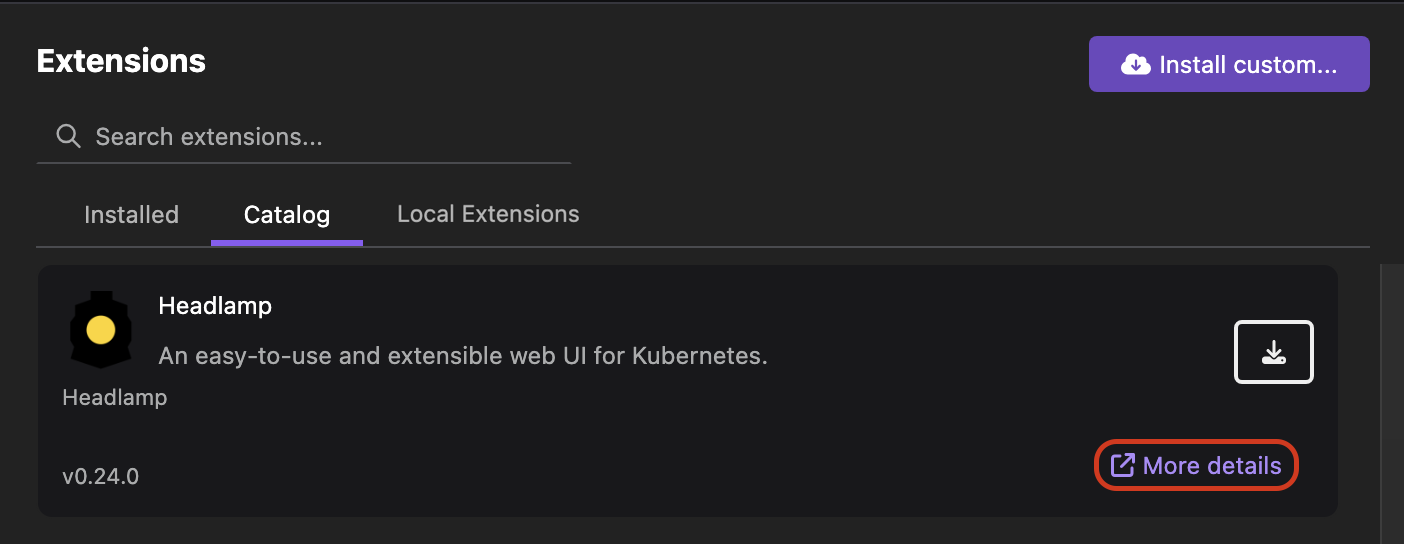Using extensions for development tasks
Podman Desktop provides a wide range of extensions that can be used to integrate your local tools with the UI. By installing extensions, you can customize your development capabilities based on your needs. For example, if you want to run a Minikube cluster, you can install the Minikube extension. List of extensions available:
Engine extensions
-
Podman: Handles creation and monitoring of Podman machines. It connects to the Podman socket so that you can see containers, images, volumes, and other resources in the Podman Desktop UI. See Podman.
-
Docker: Auto-registers the socket to Podman Desktop if any Docker engine is running on your machine. After registeration, you can monitor containers, images, volumes, and other resources from the UI. See Migrating from Docker.
Kubernetes extensions
-
Kind: Enables creating a Kubernetes cluster that you can run on a Podman engine. As a prerequisite, you must install the
kindbinary before using the extension. See Kind and Tutorial- Deploying a Kubernetes application. -
Minikube: Enables creating a Kubernetes cluster that you can run on a Podman engine. As a prerequisite, you must install the
minikubebinary before using the extension. See Minikube and Tutorial- Running a Kubernetes cluster. -
Lima: Enables creating a Lima virtual machine that you can run on a Podman engine. As a prerequisite, you must install the
limabinary before using the extension. See Lima. -
Kube Context: Enables viewing and changing the current kubernetes context. See Viewing and selecting Kubernetes context.
-
Headlamp: Enables creating an extensible Kubernetes web UI. For more details, click the More details link in the Catalog tab of the Extensions page.

CLI extensions
-
Compose: Enables setting up
composebinary so that you can runpodman composecommands. See Compose and Getting started with Compose. -
Kubectl CLI: Enables setting up
kubectlbinary so that you can runkubectlcommands. See Managing your CLI tools.
Red Hat extensions
Red Hat extension pack is a set of the following extensions that a developer can use for authentication and development purposes:
-
Podman AI Lab: Enables working and experimenting with Large Language Models (LLMs) in your local development environment. See Running LLMs locally and Tutorial- Running an AI application.
-
Bootable containers: Enables building a bootable disk image from your container image. For more details, click the More details link in the Catalog tab of the Extensions page.
-
Red Hat Account Extension: Enables you to sign in with Red Hat Single Sign-On (SSO). You can consume Red Hat content, such as RHEL container images and RPM packages without any cost. For more details, click the More details link in the Catalog tab of the Extensions page.
-
OpenShift Local: Enables running a Red Hat OpenShift Local cluster. You can manage the cluster configuration and run an application on the cluster from the UI. See Creating an OpenShift Local instance.
-
Developer Sandbox: Enables deploying your application to a shared-OpenShift Container Platform (OCP) cluster for 30 days without any cost. After configuring a sandbox environment, you can switch to the developer sandbox context and perform tasks, such as deploying a pod or container from the UI. See Configuring access to a developer sandbox.
-
OpenShift Checker: Analyzes a Containerfile and highlights the directives and commands that could cause an unexpected behavior when you run it on an OCP cluster. After identifying issues, you can update your Containerfile to make it OpenShift-compliant. For more details, click the More details link in the Catalog tab of the Extensions page.
noteYou can also install the above extensions individually from the catalog rather than installing the entire pack.
Other extensions
-
Registries: Provides some default registries so that you can connect to them with your credentials. See Managing registries.
-
Image Layers Explorer: Use this extension to explore and analyze different layers of the container image. For more details, click the More details link in the Catalog tab of the Extensions page.
Custom extensions
You can also create your own customized extension using these templates. For more details, see Developing a Podman Desktop extension and Publishing a Podman Desktop extension.